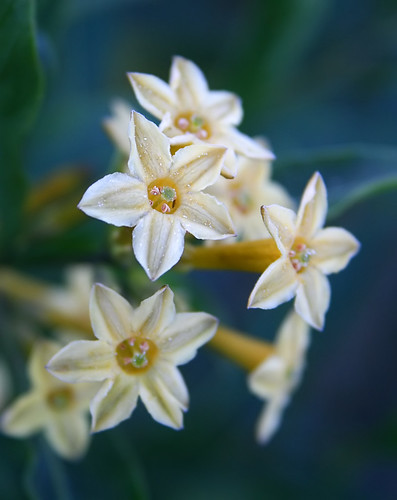It was a cold-gray-wet mid-November day in 2007. Ineke and I sat at the Starbucks across from Vancouver Public Library (the main branch, which
Moshe Safdie has humorously designed to resemble the Colosseum and give my city an imposed air of culture). This was my first time smelling
Evening Edged in Gold and my immediate reaction was that of familiarity. I couldn't quite pinpoint it at the context, so Ineke mentioned the influence of the grand woody-floriental scents from the 90's -
Feminite du Bois and
Dolce Vita, both with a pronounced cedarwood and fruity notes.
Months later, Ineke kindly sent me a sample of her new opus (by the way - Ineke has a new and beautifully packaged
sampler set, with all her 5 fragrances, titled “Volume 2” and meticulously wrapped and packaged in their miniature matchbox-like case within a larger drawer-type box), as well as the three floral bases used in the perfume. Two of the bases are ones that Ineke has created “from scratch” so to speak, using flowering plants in her garden as a reference and inspiration.
Although these floral bases play a modest role in the formulation percentage-wise (the woody and musky notes play a more dominant role here, accounting for more than half of the composition), they sure are what sets Evening Edged in Gold apart from, say, Dolce Vita and Samsara.
The Angel’s Trumpet (aka Datura) base is reminiscent of lilies and reminds me greatly of the lily-and-orange blossom saturated Lys Mediteranee, yet with a far more pronounced lily-of-the-valley note (most likely from
Phenyl Ethyl Alcohol and other muguet molecules).
The Midnight Candy base is a lot less floral that I expected it to be and smells very candy-like indeed, and has a dusky, smooth ripe-plum-like texture which goes very well with the more complex, apricoty-osmanthus base (Ineke used both osamnthus absolute and an osmanthus base for Evening Edged in Gold - I have to say I personally prefer the absolute as it is).
The Angel’s Trumpet I’ve taken pictures of (see above) did not have much of a fragrance (at least not in broad daylight). Keep in mind that I've met in in mid-day; according to Bill (Ineke's husband and business partner), it is at night time when the flower releases it's lily-like scent into the air, and the yellow variety is the one to look for (the bush I've found being peach coloured may not be as fragrant but I'm bound to check out if it's still in bloom this very evening).
Midnight Candy is the flower that “stars” in this fragrance’s packaging. Unfortunately, I haven’t smelled it either. Again, according to Bill this finicky dusky flower will only show off its olfactory capabilities on a hot day after 4pm. In a cooler day it won't be as generous sharing its fragrance. I am very curious to hear if any of you who have tried Evening Edged in Gold are familiar with these two fragrant flowers and could “find” them within Ineke’s perfume. I would love to hear from you more about the plant inspiration for this perfume.







